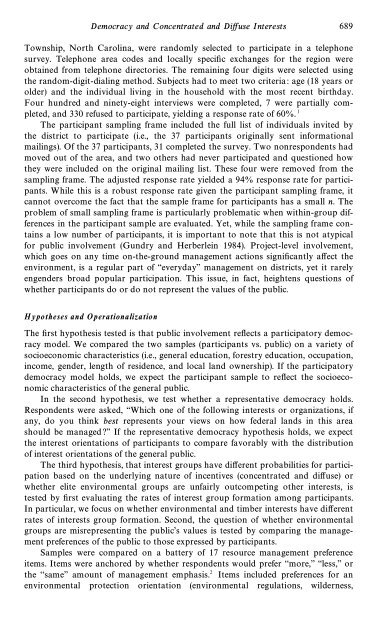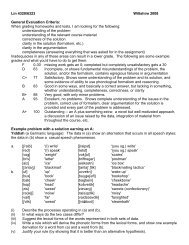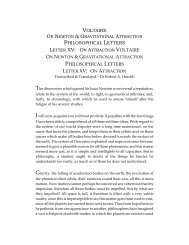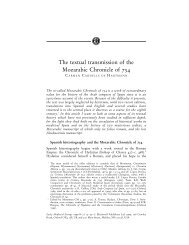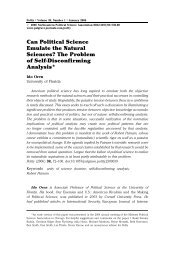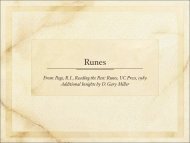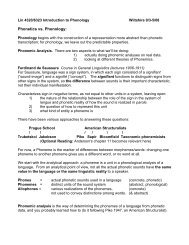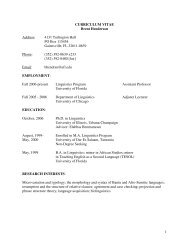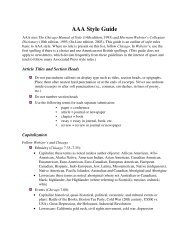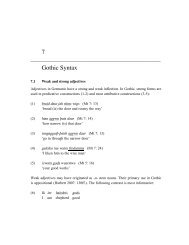Overdevest, C. 2000. Participatory Democracy, Representative ...
Overdevest, C. 2000. Participatory Democracy, Representative ...
Overdevest, C. 2000. Participatory Democracy, Representative ...
You also want an ePaper? Increase the reach of your titles
YUMPU automatically turns print PDFs into web optimized ePapers that Google loves.
<strong>Democracy</strong> and Concentrated and Di†use Interests 689Township, North Carolina, were randomly selected to participate in a telephonesurvey. Telephone area codes and locally speciÐc exchanges for the region wereobtained from telephone directories. The remaining four digits were selected usingthe random-digit-dialing method. Subjects had to meet two criteria : age (18 years orolder) and the individual living in the household with the most recent birthday.Four hundred and ninety-eight interviews were completed, 7 were partially completed,and 330 refused to participate, yielding a response rate of 60%. 1The participant sampling frame included the full list of individuals invited bythe district to participate (i.e., the 37 participants originally sent informationalmailings). Of the 37 participants, 31 completed the survey. Two nonrespondents hadmoved out of the area, and two others had never participated and questioned howthey were included on the original mailing list. These four were removed from thesampling frame. The adjusted response rate yielded a 94% response rate for participants.While this is a robust response rate given the participant sampling frame, itcannot overcome the fact that the sample frame for participants has a small n. Theproblem of small sampling frame is particularly problematic when within-group differencesin the participant sample are evaluated. Yet, while the sampling frame containsa low number of participants, it is important to note that this is not atypicalfor public involvement (Gundry and Herberlein 1984). Project-level involvement,which goes on any time on-the-ground management actions signiÐcantly a†ect theenvironment, is a regular part of ““everydayÏÏ management on districts, yet it rarelyengenders broad popular participation. This issue, in fact, heightens questions ofwhether participants do or do not represent the values of the public.H ypotheses and O perationalizationThe Ðrst hypothesis tested is that public involvement reÑects a participatory democracymodel. We compared the two samples (participants vs. public) on a variety ofsocioeconomic characteristics (i.e., general education, forestry education, occupation,income, gender, length of residence, and local land ownership). If the participatorydemocracy model holds, we expect the participant sample to reÑect the socioeconomiccharacteristics of the general public.In the second hypothesis, we test whether a representative democracy holds.Respondents were asked, ““Which one of the following interests or organizations, ifany, do you think best represents your views on how federal lands in this areashould be managed ?ÏÏ If the representative democracy hypothesis holds, we expectthe interest orientations of participants to compare favorably with the distributionof interest orientations of the general public.The third hypothesis, that interest groups have di†erent probabilities for participationbased on the underlying nature of incentives (concentrated and di†use) orwhether elite environmental groups are unfairly outcompeting other interests, istested by Ðrst evaluating the rates of interest group formation among participants.In particular, we focus on whether environmental and timber interests have di†erentrates of interests group formation. Second, the question of whether environmentalgroups are misrepresenting the publicÏs values is tested by comparing the managementpreferences of the public to those expressed by participants.Samples were compared on a battery of 17 resource management preferenceitems. Items were anchored by whether respondents would prefer ““more,ÏÏ ““less,ÏÏ orthe ““sameÏÏ amount of management emphasis. 2 Items included preferences for anenvironmental protection orientation (environmental regulations, wilderness,


